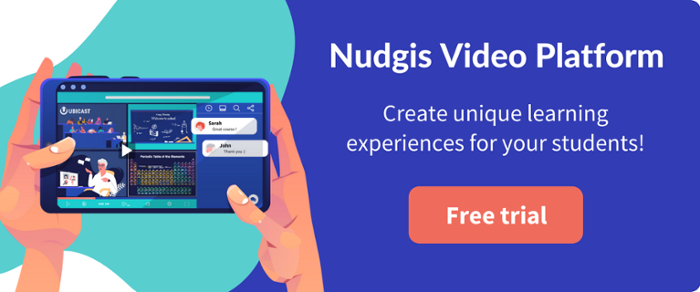So, the last class of my university course took place on a rainy Friday in July, all alone behind my screen...
A bit like this actually:
@jeanessasmith last day of school everrrrrrrrr #SkipTheRinse #college #fyp #inverted #TikTokGGT #classof2021 #graduate
♬ original sound - Jack
After a full year doing 100% online learning, there is such a strong desire to return to the classroom. The frustration of finishing one’s Master's degree at home rather than surrounded by fellow students and teachers is palpable.
And yet, even if the majority of students agree that the face-to-face format is essential, the fact remains that the health crisis has shown us that distance learning can bring real added value to educational environments.
As a proof of this. A recent study conducted by “Inside Higher Ed”, asked: "Which of the following sentences best corresponds to your post-COVID learning desire?", very nearly half of students responding (49.5%) stated that they did not wish to return to full face-to-face learning, as distance learning is beneficial and generally well adapted to their study methods, 9% said they want to take courses exclusively online. That's almost 60% of the students who favour distance learning!
In this post, I have chosen to put on my student's hat to give you my honest feelings on the academic year that I just finished, and to talk about the educational model that in my opinion should be the most appropriate for the years to come. It is important to look back at what worked and what didn't, and grab the positive takeaways out of this difficult time to try and re-imagine and build a better future for education. And above all, to make it through a student’s perspective. After all, we are the most concerned in all of this!
So here are my recommendations depending on the format you choose.
1- Distance learning
* Virtual classes: why not, but there must be a real interest
After almost a year of video-conferencing and hundreds of hours spent listening to your teacher behind a screen from 9am to 6pm, I can safely say that the Zoom fatigue (or Teams fatigue for me) is very real. Why is this? The lack of social contact, of course, but not only that... In my case, it was mainly due to a bad pedagogical format. My school chose to provide all the courses synchronously via a virtual classroom platform in order to preserve pedagogical continuity. I quickly found myself demotivated by online courses. By taking the easy way out, i.e. by copying and pasting a face-to-face lecture and transposing the format into remote virtual classroom tools, it’s not so surprising that students are finding the new structure difficult to follow. At home, we are subjected to very different stimuli - the famous temptation of doing something else if the content is not interesting or engaging enough - and trying to mimic a face to face course without taking into account the special conditions and just pretending that it is still a face-to-face course is not the best option. Hence the importance of engaging us even more when teaching remotely, otherwise we will quickly lose interest in the course, the class and all related material. How can institutions ensure engaging their audiences? By choosing a good blend of interactive tools and gamification processes and scripting their educational content.
Thanks to interactive tools such as Wooclap for example, students are way more captivated and active during the lesson and thus more inclined to interact, making the course more dynamic in the process. In short, with tools like this, you are really making us (the students) want to learn.
I have experienced it myself: some of my teachers use quizzes, polls or word clouds to make the courses more dynamic through tools like Wooclap or Kahoot! and the results are there: my attention and focus on the subject at hand increased exponentially because I felt involved in the course which was presented in a more engaging way, and I felt curious to know more and like I wanted to participate.
* Video capsules: the best format for theory content
If you want to give your students autonomy and a sense of ownership and flexibility in their learning, video capsules are a great choice. You record your theoretical material: forget about two-hour lectures, instead split your content in easy to digest videos of approximately 10 to 15 minutes that will cover the essential concepts of a topic in a more fun and interactive way thanks to the features offered by the digital learning platform your institution is using.
At UbiCast, we offer Nudgis video platform which empowers teachers to record their lessons in their traditional classroom, in a recording studio or independently from their Computer thanks to WebStudio. Once the video is uploaded, our automated AI will index the content and audio, recognizing important points of the material such as keywords and time markers, allowing students to search for specific moments of interest and get more context out of our point of interest. Most importantly, the platform features an interactive content player with social learning capabilities, allowing students to contribute to video’s timeline with comments, links, photos or even full files (much as they would on social media), thereby adding more value to the original content with additional resources, and participate in polls and comprehension quizzes set by the content creators.
This type of videos and mixed media tools make it much easier to engage students remotely and asynchronously, but more importantly they allow teachers to offer a teaching scheme that is more in line with students' expectations. As you can see from the graph below (source: Inside Higher Ed, "COVID-Era College: Are Students Satisfied?"), students want to see a wider use of the online format, which allows them to work at their own pace and gives them greater flexibility.
In my personal experience the problem with synchronous courses is that they do not encourage note-taking. On the contrary, I often found myself not having the time to write down the things I wanted to, or even worse not understanding my notes after class. As I was afraid of losing key information, I often transcribed what the teacher was saying without really assimilating the content. Video capsules allow students to move forward as they wish and to revisit key concepts, while being able to interact with the content by asking questions or even taking notes on specific moments for example. This really helps with context and retention of information because we can easily find the right place in the capsule.
On the other hand, it is important that teachers script their educational content as much as possible to bring a different dynamic. During one of our last webinars here at UbiCast, our guests speakers Jeff Van de Poël and Sandrine Karam told us:
« It is important to integrate video into pedagogical scenarios that go in depth rather than encouraging binge watching of content that remains on the surface ».
Jeff Van de Poël (Deputy Director of digital affairs at the University of Lausanne's teaching support centre)
« In terms of audiovisual formats, there can be a lot of creativity: scripted videos made by students, interviews, fictional videos, course teasing... We should not limit ourselves to the virtual classroom, we can be interactive in other ways by producing resources. Educational video comes down to asking yourself how to script your content. ».
Sandrine Karam (Deputy Director of skills and FTLV and referent of the Medialab at the University of Limoges)
If you opt for this format, you know what you have to do!
2- Face-to-face learning
My student experience would not have been the same without a university campus. From a personal point of view, it was difficult for me this year not to be able to meet my professors and classmates in person, or to take advantage of the facilities at my institution. According to the Inside Higher Ed survey, this feeling is clearly confirmed by students in general, as 73% say that what they miss most is meeting friends and having a social life on campus during this period.
Face-to-face learning is therefore obviously ESSENTIAL in the post-COVID model, if only to maintain the social link outside the digital sphere, but it is also essential pedagogically speaking to ensure student success. As I said in my previous article: a video-based learning method is beneficial if and only if it is well supervised and complemented by face-to-face learning.
From my experience, I would say that group work as well as collaborative learning is greatly facilitated in this setting. Learning in a classroom setting can also be beneficial in the way that it encourages students to participate more and develop critical thinking skills, especially when interacting with other students. In this active learning method, students are able to express themselves and communicate more, which further engages them, and increases their level of concentration and assimilation.
In contrast to lectures, which often do not add any value when given in a lecture theatre, tutorials and practical work are two course formats that fit very well into this face-to-face model as they are built on interaction and practice.
Conclusion: My post-COVID teaching model
So, to the question "How can we combat course fatigue?", I answer: "By proposing a model that encourages a diversity of formats (provided, of course, that they are used optimally)."
The idea would be to combine formats to make courses lively in face-to-face as well as in remote learning! This would then follow the principle of hybrid teaching and flipped classrooms. The best of each format is used to ensure the success of the students by offering them a learning method that corresponds to them.
Tutorials and practical work would take place face-to-face, while the purely theoretical courses would take place remotely through video capsules to offer flexibility and autonomy to the students and through virtual classes from time to time in sub-groups, making the content fun by using interactive tools.
I think that the health crisis and the all-distance learning experienced this year have shown us two things:
- Remote learning is appreciated by students when used in the right way, especially because it allows them to organise themselves as they wish and to follow the courses at their own pace.
- Face-to-face remains essential for campus life and for practice-oriented courses.
From this observation, it seems logical to propose a hybrid model based on flipped classrooms or even flexible teaching (HyFlex Model).
The variety of formats is crucial in order not to impose on students, as it was my case for almost a year, days of classes with 8 hours of synchronous videos. Professors need to coordinate and higher education institutions need to set up a pedagogical model that will allow for a diversification of teaching formats for greater dynamism, and above all that will correspond to the expectations and needs of students.
As Rémy Challe (former director of EdTech France) pointed out in a recent article by Siècle Digital: "The teacher's posture must change. You can no longer come into a classroom and deliver information that is available elsewhere. The teacher must be able to put it into motion, so that it becomes knowledge [...] it will probably be necessary to accept the fact that the teacher is moving away from the role of scholar, and taking on the role of facilitator of knowledge, and accompanist.” And this fits in perfectly with a transition to a pedagogical model with various formats, each format providing an essential component in student success.

 by:Jeanne Aimerie on: September 20, 2021
by:Jeanne Aimerie on: September 20, 2021

-2.png)
